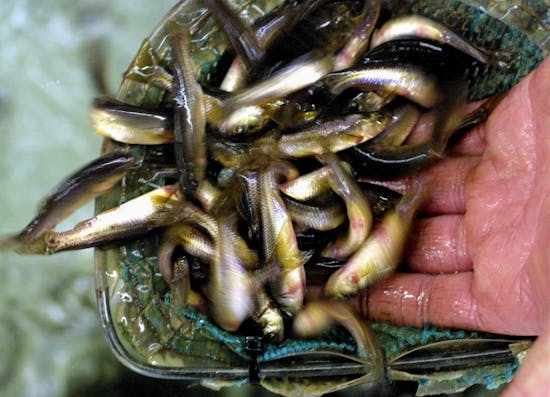Golden shiners, a shimmering live bait favored by winter walleye anglers, are at the center of an escalating policy dispute between bait shops barred from importing the minnows and fisheries managers upholding the ban as a critical defense against fish disease and invasive carp.
For years, the Department of Natural Resources (DNR) has prevailed in arguments over the ban, which prevents Minnesota bait dealers from buying the shiners from other states, including the bountiful fish farm industry of Arkansas. Baby Asian carp are difficult to distinguish from golden shiners, and the DNR also fears accidental travel of viral hemorrhagic septicemia (VHS), a deadly infectious fish disease that has been moving from state to state.
But now the state's 500 to 800 bait dealers have a powerful ally in the state Senate who says she is convinced that Arkansas minnows are "bio-secure" and worthy of Minnesota bait buckets.
"We'll prove this is a really good idea," said Sen. Carrie Ruud, R-Breezy Point, chairwoman of the Senate Environment and Natural Resources Policy and Legacy Finance Committee. "If we want to expand and support fishing in Minnesota, we have to do a better job."
In a letter last week to Senate leaders, DNR Commissioner Tom Landwehr included the minnow controversy as one of several "problematic policy items" that deserves its own debate and should not be part of the budget bill dominating the DNR agenda this year at the Capitol.
"Allowing the importation of golden shiner minnows … will present a serious risk of introductions of environmentally devastating invasive species,'' Landwehr wrote.
In a 2013 report to the Legislature, the DNR concluded that the importation of live minnows — even for feeding to hatchery fish — would be a high-risk potential pathway to inland lakes for black carp, bighead carp, grass carp and silver carp, all designated as prohibited invasive species in Minnesota.
The report also showed how golden shiners occupy a hearty niche of the state's annual minnow sales. Of the 195,000 pounds of minnows sold in Minnesota in 2011, 6 percent were golden shiners, the report said. The statewide trade is dominated (75 percent) by the sale of fathead minnows, and golden shiners rank third in sales behind white suckers.
Marshall Koep, who operates Urbank Live Bait Co. in Clitherall, Minn., said demand for golden shiners by ice anglers far outweighs the annual supply that Minnesotans raise in state-approved rearing ponds. Those sites are harvested each fall. The state's "growing season'' of summer water temperatures is short and the number of approved ponds and wetlands needed to grow the baitfish has diminished over the past few decades, he said.
"My father used to rear in 200 minnow ponds, now we're down to 60,'' Koep said. "And we have a short growing season compared with 10 months of growing in Arkansas.''
Koep said bait dealers appreciate the support of Ruud, who comes from a district with more than 800 lakes, and they hope to meet soon with a representative of Gov. Mark Dayton to plead for his support.
Koep said Arkansas meets all the certifications required of nearly every U.S. state for safe export of minnows. Only Minnesota and Maine ban the imports for fishing, he said. Wisconsin is a large importer of minnows from Arkansas, both as bait and for feed for hatchery fish. A lot of those golden shiners have been making their way into Minnesota for fishing without any detriments, Koep said.
"We've been trying to get this passed for several years,'' he said.
DNR Fisheries Chief Don Pereira and DNR Ecological and Water Resources Section Manager Ann Pierce testified last month before a Senate committee, fighting the proposal to open the state to golden shiner imports.
Periera said in an interview this week that minnow importation is still a high-risk pathway for invasive species, including the European rudd, a sort of mini-grass carp that multiplies and feeds voraciously, turning lakes turbid and unhealthy for waterfowl and shorebirds. Minnesota is spending millions of dollars a year to fight invasive aquatic species, but Pereira said the golden shiner legislation seems to be sweeping caution and past study findings under the rug.
He acknowledged the annual shortage of golden shiners for angling in Minnesota but questioned why the state should take the risk of giving Asian carp a new route to state lakes in order to appease a certain group of anglers and "high-end" bait dealers for part of the ice fishing season.
Pereira said intensive farming conditions are prime places for pathogens to grow and even if another state's fish farming companies are as "bio-secure'' as proponents claim, there's a chance they aren't screening or monitoring for all possible diseases and invasive species, Pereira said.
"There's diseases and pathogens we don't even know about yet,'' he said.
Pereira also said Minnesotans shouldn't follow in the footsteps of other states when its own scientists see problems with the importation of minnows for fishing.
"It's lots of high-level risks that are all bad for the benefit of a small number of people,'' Pereira said.
Ruud said her golden shiner proposal is now included in the omnibus environment bill in the Senate, which has yet to reach the floor. There's a companion bill in the House.





